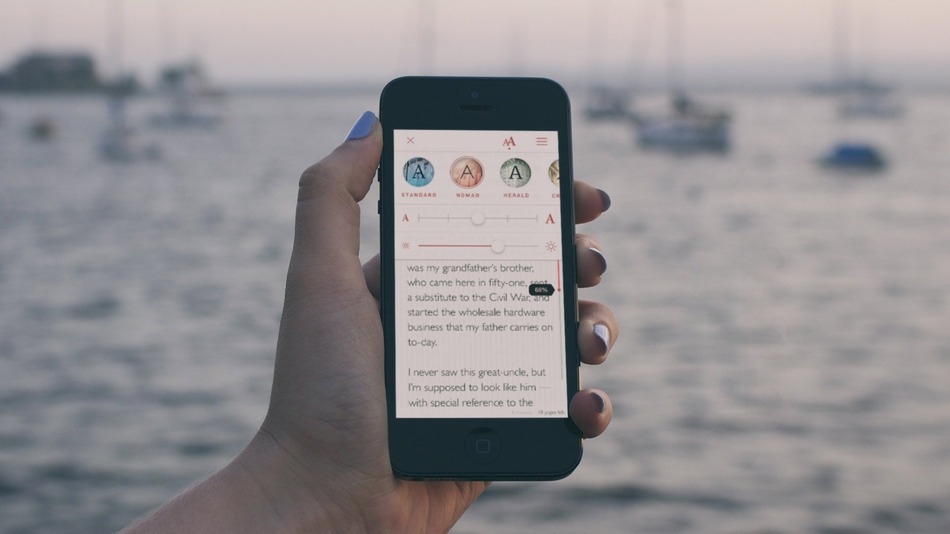The public library became my second home early on in my life. I happily visited my library for weekly doses of a seemingly endless selection of books, without worrying about the possibility of bankruptcy. When Amazon released the Kindle in 2007, I scoffed at the concept of paying for books I could simply borrow from the library. Still committed to paper-and-ink reading, I, like many of my peers, favored nostalgia and waxed poetic about “that irreplaceable thrill of turning to the next page.” College, however, has limited the time I have to venture to the library. For the first time, I understand the appeal of e-readers that allow me to download books on a whim, but I am still reluctant to purchase every book I want to read. Then, I heard about Oyster.
Think of Oyster as a streaming service for books. For a fee of $9.95 per month, Oyster subscribers can borrow books from a library of over a million titles to read on their smartphones and web browsers. Oyster embodies the independent spirit of the digital age. Launched in 2012 as a New York-based startup receiving seed funding from a venture capital firm, Oyster has since catapulted to success. The company has deals with major publishing houses such as HarperCollins and Simon & Schuster, as well as with several smaller firms. While Scribd and Amazon’s Kindle Unlimited introduced similar services in 2013, tech outlets have singled out Oyster for its attractive user interface and ease of navigation.
Some question the feasibility of Oyster and other e-reading subscription businesses. Pew Research Center reported that the typical American read only five books in 2013. For this “typical American,” spending $119.40 for a year-long subscription to Oyster in exchange for five books is probably irrational. But, Oyster’s marketing does not target “typical Americans.” Rather, it targets a younger generation of literary enthusiasts. For instance, the company’s website features a banner that rotates through descriptions of a person who might enjoy Oyster. All begin with “You might be an Oyster reader if you’ve ever…” and end with qualifiers like: “skipped a party to read in bed alone” or “dated someone purely because of their taste in books.” The marketing technique is unique and effective. Kindle Unlimited and Scribd advertise themselves as products for all ages and types of people, and their customers often believe that these products will motivate them to read more. In contrast, by acknowledging that it is not for everyone, Oyster creates a sense of exclusivity for its customers, thus successfully broadening its appeal.
The driving concept behind Oyster is familiar; media subscription services have steadily gained popularity since the beginning of the 21st century. About 40 percent of households currently subscribe to companies like Netflix and Hulu for access to a wide selection of movies and television shows. Meanwhile, Spotify has now reached 60 million users, including 15 million subscribers, for its music streaming services. While subscription services have increased the accessibility of media nationwide, however, other businesses face negative consequences. Netflix’s growth was a primary cause of Blockbuster’s bankruptcy in 2010, and earlier this year the Cabletelevision Advertising Bureau estimated that online video subscription services were responsible for up to 40 percent of the decline in television ratings in the last quarter. iTunes has reported dropping revenue from album sales. With the rise of Oyster, could similarly grim futures await libraries and bookstores?
Oyster’s threat to libraries is dubious at best. According to the American Libraries Association, public libraries operate on a budget depending primarily on local government funds, with the federal government contributing a smaller portion. Less than 8 percent of the library’s budget comes directly from patrons through overdue fees or fines for lost or damaged books. Therefore, the growing number of Oyster’s subscribers provides no foreseeable risk to the funding available for libraries.
Bookstores, which already faced uphill battles following the introduction of e-readers and during the recession, are another story. Barnes and Noble, one of the last major chains standing, managed to survive by releasing the Nook in the e-reading market. Yet, similar to Spotify’s impact on iTunes, the introduction of e-book subscription services may result in fewer purchases of individual books on Nooks and Kindles over the next few years. And just as rumors buzz that iTunes may soon launch its own music subscription service, companies such as Barnes and Noble will probably release their own products in time to compete with Oyster and stay in business.
Most industry analysts agree that it is too early to definitively assert Oyster‘s danger to other book dealers. Publishers and consumers still believe in the reliability of printed text, which is why libraries continue to exist and why bookstores can anticipate a long life ahead. And this is a good thing, because I’m not done feeling that irreplaceable thrill of turning to the next page.
– By Shuchi Goyal/Photo Credit: NY Post


